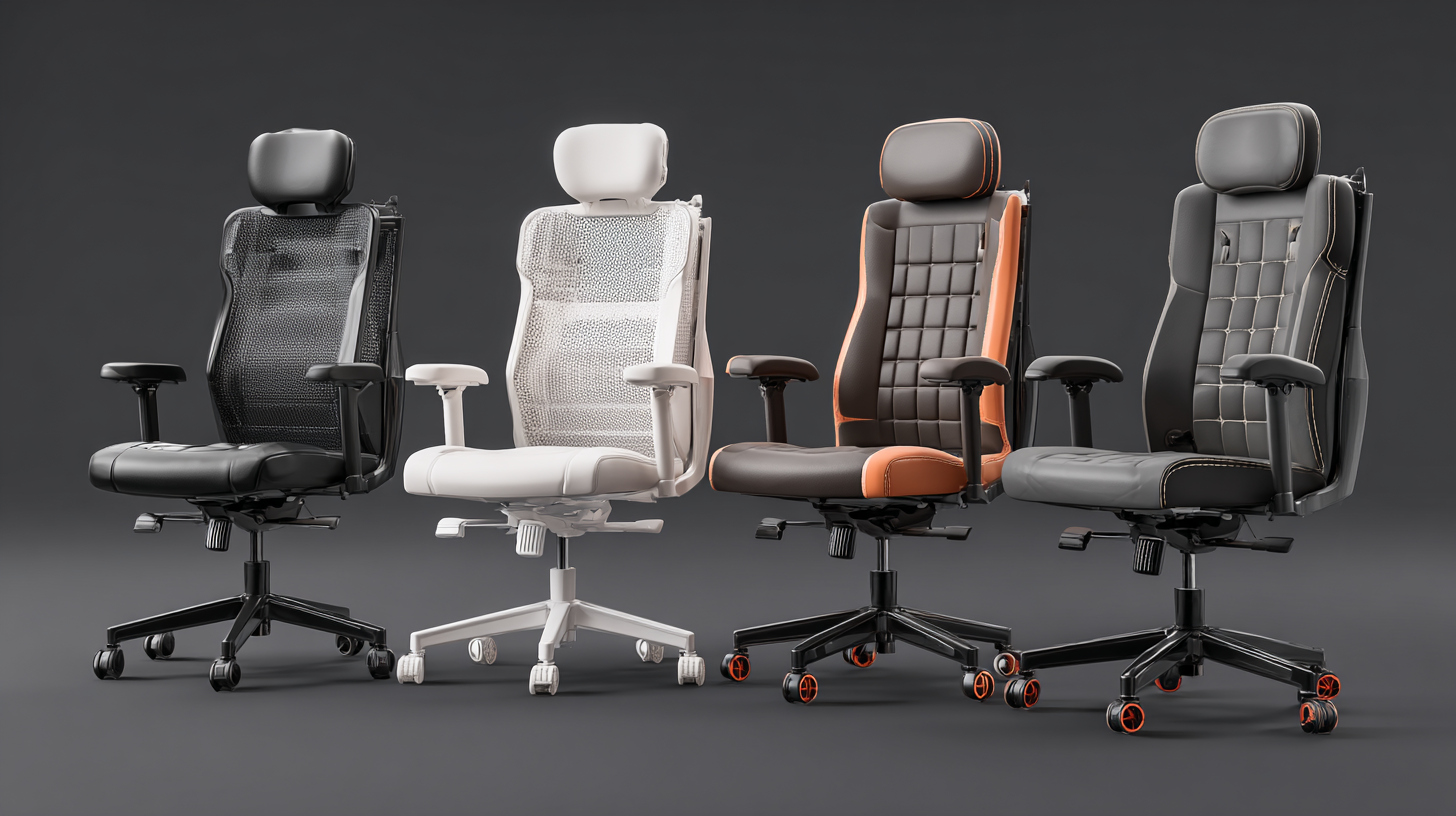Understanding the Common Issues with the Best Office Chair Design
In today’s fast-paced work environment, the importance of a well-designed office chair cannot be overstated. Studies have shown that employees spend an average of 8 hours a day seated, which significantly impacts their health and productivity. According to the American Chiropractic Association, poor seating ergonomics contributes to a staggering 60% of work-related back injuries. Furthermore, a report by the Global Industry Analysts predicts that the global office chair market will reach $12.5 billion by 2025, driven by the rising awareness of workplace comfort and health among employers. As businesses strive to enhance employee well-being, understanding the common issues associated with various office chair designs becomes essential. This blog will explore the specific characteristics and suitability of different types of office chairs, helping you make informed choices for your workspace.
Common Ergonomic Mistakes in Office Chair Design and Their Impact on Health
When selecting an office chair, many individuals overlook the crucial aspect of ergonomic design, often leading to common mistakes that can impact their health significantly. One major error is choosing a chair that lacks sufficient lumbar support, which can result in back pain and discomfort during long hours of sitting. Additionally, the height of the chair should be adjustable to ensure that the feet rest flat on the ground, promoting better posture and circulation. Failing to adjust the armrests can also lead to shoulder strain, as improperly positioned armrests can lead to elevated shoulders and tension.

Furthermore, the material and cushioning of the chair play a vital role in comfort and health. Many chairs adopt a design that prioritizes aesthetics over functionality, resulting in inadequate support. It's essential for users to test different options to find a chair that conforms to their body shape, providing both comfort and necessary support. Often, reviews promoting "the best chair" may disguise potential ergonomic flaws, driven by hidden commissions rather than genuine well-being. Therefore, understanding these common ergonomic pits can help individuals make informed decisions, ultimately enhancing their productivity and overall health in the workspace.
Key Features of High-Quality Office Chairs Supported by Industry Studies
When it comes to selecting an office chair, understanding the key features that define a high-quality design is essential for ensuring comfort and productivity. According to a study conducted by the American Chiropractic Association, ergonomic chairs can significantly reduce the risk of musculoskeletal disorders. In fact, 88% of users reported reduced back pain after switching to an ergonomic chair, showcasing the direct impact of proper design on health and well-being.
In addition to ergonomic support, breathability and adjustability are crucial elements that contribute to chair quality. A report from the International Journal of Industrial Ergonomics highlights that chairs with adjustable seat height and lumbar support can lead to a 25% increase in productivity among office workers. Furthermore, materials that promote airflow, such as mesh, can enhance comfort during prolonged sitting. The right office chair not only supports the body but also fosters an environment that encourages focus and efficiency, backed by significant findings from industry studies.

Assessing Lumbar Support: Best Practices for Comfort and Alignment
When assessing lumbar support in office chair design, it’s crucial to recognize its impact on comfort and alignment. Research from the American Chiropractic Association indicates that nearly 80% of adults experience back pain at some point in their lives, often exacerbated by poor seating choices. An ergonomic chair with adequate lumbar support aligns the spine's natural curve, reducing the risk of strain and promoting better posture throughout the workday.
A study published by the Journal of Occupational Health found that employees who utilized chairs with adjustable lumbar support reported a 35% decrease in discomfort levels compared to those using conventional chairs. Best practices for lumbar support include adjustable backrests that can adapt to the individual's spine curvature, as well as materials that provide both firmness and cushioning. It’s essential for office chair designs to incorporate features that facilitate customization, catering to diverse body types and preferences, thereby fostering a healthier work environment.
Materials Matter: How Chair Fabric Choices Affect Durability and User Experience
When selecting an office chair, the choice of fabric can significantly impact both durability and user experience. According to a recent study by the International Journal of Industrial Ergonomics, the right chair fabric can enhance comfort and productivity, proving that materials matter more than just aesthetics. For instance, breathable mesh fabrics are reported to increase air circulation and reduce heat build-up, which can result in up to 14% higher productivity among users over extended periods of seated work.
Additionally, different fabric types come with varying levels of durability. A report by Furniture Today indicates that commercial-grade upholstery, such as high-performance fabrics, can withstand up to 50,000 double rubs, compared to standard upholstery, which may only endure about 20,000. Investing in chairs made from robust materials not only prolongs the lifespan of the office seating but also ensures that users maintain a consistent level of comfort throughout their workday. Hence, when considering office chair design, employers and consumers alike should prioritize fabric quality to enhance long-term satisfaction and overall workplace efficiency.
Impact of Chair Fabric Choices on Durability and User Experience
The Role of Adjustability in Office Chair Performance: Insights from Ergonomic Research
When it comes to office chair design, adjustability plays a crucial role in enhancing performance and user comfort. Ergonomic research has consistently highlighted that chairs capable of accommodating a wide range of body types and personal preferences reduce discomfort and the risk of musculoskeletal disorders. According to a study published in the Journal of Human Factors, adjustable chairs can decrease the incidence of back pain by up to 40%. This underscores the importance of features such as seat height, lumbar support, and armrest adjustments.
Moreover, the Adjustability in Ergonomics report from the International Journal of Occupational Safety and Health indicates that employees who use adjustable office chairs report a 13% increase in productivity. The ability to tailor a chair to individual needs not only contributes to physical well-being but also enhances concentration and job satisfaction. As workplaces continue to evolve, investing in high-quality, adjustable chairs is becoming a critical factor in employee retention and performance, making ergonomic design more relevant than ever.
Understanding the Common Issues with the Best Office Chair Design - The Role of Adjustability in Office Chair Performance: Insights from Ergonomic Research
| Issue |
Description |
Adjustability Impact |
Ergonomic Recommendation |
| Lumbar Support |
Inadequate support can lead to lower back pain. |
Proper lumbar adjustability can significantly reduce discomfort. |
Choose chairs with adjustable lumbar support that fits the natural curve of the spine. |
| Seat Depth |
Too deep or shallow can strain the legs or hinder circulation. |
Adjustable seat depth can enhance comfort for different body sizes. |
Opt for chairs that allow seat depth adjustments to ensure proper leg support. |
| Armrest Height |
Fixed armrests may cause shoulder strain if not at the right height. |
Adjustable armrests can alleviate neck and shoulder tension. |
Select chairs with adjustable height armrests to promote better posture. |
| Backrest Angle |
Fixed angles may not suit all users or tasks, leading to discomfort. |
A reclining backrest provides flexibility and reduces pressure on the spine. |
Choose chairs with adjustable backrest angles to support various sitting positions. |
| Height Adjustment |
Improper seat height can lead to poor circulation and discomfort. |
Height adjustability is crucial for proper alignment with desks. |
Ensure the chair has easy height adjustment features for optimal ergonomics. |







